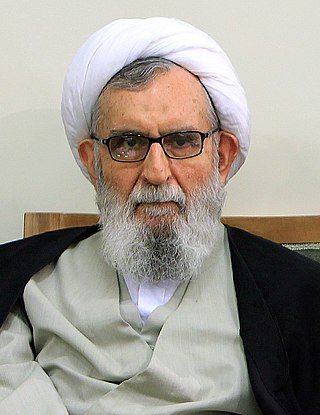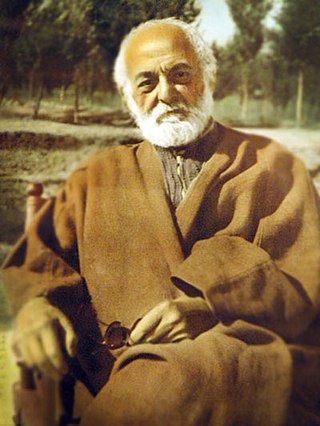Related Research Articles
Al-Quds is an Arabic name for Jerusalem

Bonyads are charitable trusts in Iran that play a major role in Iran's non-petroleum economy, controlling an estimated 20% of Iran's GDP, and channeling revenues to groups supporting the Islamic Republic. Exempt from taxes, they have been called "bloated," and "a major weakness of Iran's economy." They have also been criticized for reaping "huge subsidies from government," while siphoning off production to the lucrative black market and providing limited and inadequate charity to the poor.

Mashhad, also spelled Mashad, is the second-most-populous city in Iran, located in the relatively remote north-east of the country about 900 kilometres from Tehran. It serves as the capital of Razavi Khorasan Province and has a population about 3,400,000, which includes the areas of Mashhad Taman and Torqabeh.

Razavi Khorasan Province is one of the 31 provinces of Iran, located in northeastern Iran. The city of Mashhad is the center and capital of the province. Razavi Khorasan is one of the three provinces that were created after the division of Khorasan province in 2004. In 2014, it was placed in Region 5 with Mashhad as the location of the region's secretariat.

The Central Library of Astan Quds Razavi is a large library in Mashad, Iran. Established before 1457, it holds over 1.1 million volumes. It is an international center for Islamic research, containing numerous manuscripts and rare works of antiquity of Islamic history.

Abbas Vaez Tabasi was an influential Iranian cleric who held memberships at different institutions. He was Grand Imam and Chairman of the Astan Quds Razavi board from 1979 until his death in 2016.

Astan Quds Razavi is a bonyad based at Mashhad, Iran. It is the administrative organization which manages the Imam Reza shrine and various institutions which belong to the organization.

The Imam Reza shrine in Mashhad, Iran, is a complex which contains the mausoleum of Imam Reza, aka Ali al-Rida or Ali al-Ridha, the eighth Imam of Twelver Shias. It is the largest mosque in the world by area. Also contained within the complex are the Goharshad Mosque, a museum, a library, four seminaries, a cemetery, the Razavi University of Islamic Sciences, a dining hall for pilgrims, vast prayer halls, and other buildings.

Shahr Khodro Football Club, previously known as Padideh, is an Iranian football club based in Mashhad, Razavi Khorasan, that competes in the Persian Gulf Pro League. The club was founded in 2013 and was known as Padideh Khorasan Football Club between 2013 and 2019, and between March and August 2021.

Hajj Hossein Malek was an Iranian philanthropist.

Grand Ayatollah Sayyed Abdullah Al-Musawi Al-Shirazi was a Grand Ayatollah of Twelver Shi'a Islam.

The Imam Reza Stadium is an all-seated football stadium located in Mashhad, Iran. The stadium has a seating capacity of 27,700 and is the sixth biggest stadium in Iran. It hosts some matches of the Iran national football team. The stadium completed in January 2017 and was opened on 14 March 2017 on the day of Chaharshanbe Suri.
Hatem Beg Ordubadi, was an Iranian bureaucrat from the Ordubadi family, who served as the grand vizier of the Safavid shah (king) Shah Abbas I from 1591 to 1610/1.
Mehdi Azizian is an Iranian businessman and economist who was President and CEO of Astan Quds Razavi (AQR) from 1 March 2014 until 29 March 2016. He was previously Economic Vice President of the company.
Gholamreza Ghodsi was a belletrist and poet from Mashhad, Iran.
The following is a timeline of the history of the city of Mashhad, Iran.

Ahmad Marvi is an Iranian Twelver Shia cleric, former general and former police officer who has recently been appointed as the custodian of Astan Quds Razavi by the decree of the supreme leader of Iran, Seyyed Ali Khamenei.

Soltan Mohammad Mirza better known by his honorific title Sayf ol-Dowleh was an Iranian prince of the Qajar dynasty and thirty-ninth son of Fath-Ali Shah, king of Qajar Iran. He was the governor of Isfahan between 1820 and 1835 and contributed to its restoration after the damage it suffered in the civil war between Zand sovereigns and Agha Mohammad Khan, rebuilding several of the Safavid pavilions and designing his own palace.

Sadegh Amirazizi (1905–1992) was an Imperial Iranian Army general and a politician who served as the minister of interior three times during the reign of Shah Mohammad Reza Pahlavi. Following the 1979 revolution he left Iran and settled in Paris, France. He died there in 1992 and buried in Behest e Zahra Cemetery in Iran.
With the establishment of the Safavid dynasty, Shiism was declared the official religion of Iran. In implementing this purpose, the Safavid kings developed the holy places as a place for the Shia people by expanding the culture of endowment and creating endowments. The shrine of Imam Reza in Mashhad, the only tomb of Shia imams in Iran, was the most important religious shrine and the Safavids' focus. The Safavid kings tried to expand it in various ways, including allocating government budgets and endowments and giving ornaments and charity. One of the significant results of their performance was the increase in endowments of the Imam Reza shrine, which continued in the direction of creating a center for the spread of Shia culture, its prosperity, and continuity.
References
- The Astan Quds Razavi Museum; Heshmat Kafili, in collaboration with Maryam Habibi Qa'ini By'gi and Muhammad Reza Shahroody Zadeh, First Edition, 2017